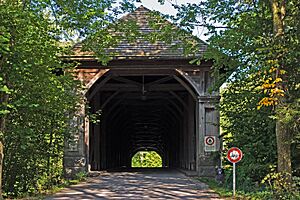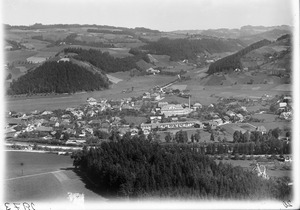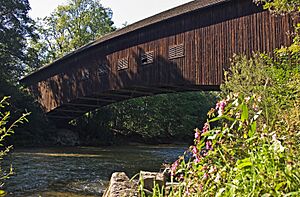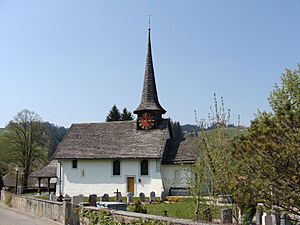Rüegsau facts for kids
Quick facts for kids
Rüegsau
|
||
|---|---|---|
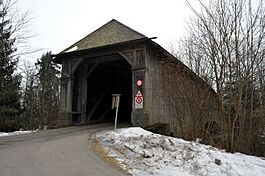
Covered wood bridge of Hasle-Rüegsau.
|
||
|
||
| Country | Switzerland | |
| Canton | Bern | |
| District | Emmental | |
| Area | ||
| • Total | 15.06 km2 (5.81 sq mi) | |
| Elevation | 589 m (1,932 ft) | |
| Population
(Dec 2020 )
|
||
| • Total | 3,265 | |
| • Density | 216.80/km2 (561.51/sq mi) | |
| Postal code |
3417
|
|
| Surrounded by | Affoltern im Emmental, Hasle bei Burgdorf, Heimiswil, Lützelflüh, Sumiswald | |
Rüegsau is a town in the Emmental area of Swiss canton of Bern.
Contents
History of Rüegsau
Rüegsau was first mentioned in old writings in 1139 as Ruxow. Later, in 1229, it was called Ruchisowe. The name comes from words that mean "calm floodplain" in modern German.
From the late 1200s until 1528, Rüegsau was home to the Rüegsau Priory. This was a special place where Benedictine nuns lived and prayed.
The oldest sign of people living here is a stone tool from the neolithic (New Stone Age) found in Rüegsau village. The first signs of a modern settlement appeared in the early 1100s. This was likely when the Rüegsau Abbey (a type of monastery) was started. We don't know much about the abbey's early days. It was probably founded by Thüring von Lützelflüh, who also started another abbey nearby. It's not clear if the village grew around the abbey or if it was already there.
The first known leader of the abbey, called a provost, was there between 1256 and 1299. A Meisterin (a female leader) was in charge of the nuns in 1320. An abbess (the head nun) was first mentioned between 1526 and 1528. The abbey controlled parts of the lower Emmental area, including Rüegsau and Affoltern im Emmental. In 1454, it even had its own seal (a special stamp).
In 1528, the city of Bern changed to the new Protestant Reformation faith. In the same year, Bern took control of all monasteries, including Rüegsau Abbey. The abbey's property was then used to pay the priests of Rüegsau and Lützelflüh. Some of the abbey buildings became a priest's house. The rest of the buildings were slowly taken apart. The last parts of the old walls were removed between 1825 and 1831.
The church that belonged to the priory became the village church. It was fixed up in 1789–1790 and made bigger in 1874. More repairs happened in 1947, 1990, and 1999.
In 1763, a wooden, covered bridge was built over the Emme river. This bridge connected Hasle bei Burgdorf and Rüegsau. In 1881, a railroad built a station in Hasle-Rüegsau. The railroad and a new road in 1899 brought factories to what used to be a farming village. Today, service jobs are more common than factory jobs. However, farming and making things are still important parts of the local economy.
Geography of Rüegsau
Rüegsau is located in the lower part of the Emmental region. It follows the Emme river and then stretches towards the northeast. The town includes the villages of Rüegsauschachen, Rüegsau, Rüegsbach, and Rinderbach. It also has several smaller settlements called hamlets. The town is roughly shaped like a rectangle, about 2 kilometers (1.2 miles) wide and 8 kilometers (5 miles) long.
Rüegsau covers an area of about 15.1 square kilometers (5.8 square miles). As of 2005-2006, about 67.3% of the land is used for farming. About 23.1% is covered by forests. The rest of the town, about 8.6%, has buildings or roads. A small part, 0.9%, is rivers or lakes.
From the same survey, houses and other buildings make up 5.2% of the land. Roads and other transport areas make up 2.3%. About 20.6% of the land is dense forest. Another 2.5% has orchards or small groups of trees. For farming land, 19.9% is used for growing crops. About 45.6% is used for pastures (where animals graze). Only 1.8% is used for orchards or vineyards. All the water in the town is flowing water, like rivers.
On December 31, 2009, the old district of Trachselwald was closed. The next day, January 1, 2010, Rüegsau became part of the new Verwaltungskreis Emmental (an administrative district).
Rüegsau's Coat of Arms
The blazon (official description) of Rüegsau's coat of arms is: "Per pale Gules a Latin Cross pattee couped Argent and of the last a Bend wavy Azure." This means the shield is split down the middle. One side is red with a silver cross. The other side is silver with a wavy blue stripe.
People of Rüegsau
Rüegsau has a population of about 3,087 people (as of December 2012). In 2012, about 3.9% of the people living there were foreign nationals. Between 2010 and 2012, the population grew by 1.3%. This growth was mostly due to people moving into the town.
Most people in Rüegsau (about 97.5% in 2000) speak German as their main language. Italian is the second most common language (0.4%), and French is third (0.4%).
In 2013, about 49.3% of the population was male and 50.7% was female. Most people were Swiss citizens. In 2000, about 37.3% of the people were born in Rüegsau and still lived there. About 43.5% were born in the same canton (Bern).
As of 2012, children and teenagers (0–19 years old) make up 20.7% of the population. Adults (20–64 years old) make up 59.8%. Seniors (over 64 years old) make up 19.6%.
In 2000, about 1,225 people in the town were single and had never been married. There were 1,393 married people, 217 widows or widowers, and 100 divorced people.
In 2010, there were 380 homes with only one person living in them. There were 98 homes with five or more people. In 2000, most apartments (90.7%) were lived in all the time. A small number (6.6%) were used only at certain times of the year, and 2.7% were empty. In 2012, new homes were being built at a rate of 4.5 new homes for every 1000 people. In 2013, only 0.3% of homes were empty. In 2012, single-family homes made up 41.2% of all housing in the town.
The chart below shows how the population has changed over time:

Economy and Jobs in Rüegsau
The main office of Blaser Swisslube AG is in Rüegsau. This company is a top maker of cooling agents and lubricants used in factories.
In 2011, Rüegsau had a low unemployment rate of 1.28%. That year, 1,231 people worked in the town.
- About 215 people worked in the primary economic sector, which includes farming. There were 69 businesses in this area.
- The secondary sector (making things) employed 408 people. There were 37 businesses in this sector.
- The tertiary sector (service jobs) employed 608 people. There were 123 businesses in this sector.
Overall, 1,532 residents of the town had jobs. About 42.2% of these workers were female.
In 2008, there were 962 full-time equivalent jobs (meaning all part-time jobs were counted as full-time).
- 153 jobs were in farming.
- 355 jobs were in the secondary sector. Most of these (90.4%) were in manufacturing (making goods). About 8.7% were in construction.
- 454 jobs were in the tertiary (service) sector. Many of these (50.4%) were in sales or vehicle repair. Other jobs included moving goods (4.8%), hotels or restaurants (7.3%), finance (2.2%), science (4.8%), education (8.6%), and health care (15.0%).
In 2000, 460 workers came into Rüegsau for their jobs. However, 961 workers left Rüegsau to work elsewhere. This means more people leave the town for work than come in. About 571 workers (55.4% of all workers in the town) both lived and worked in Rüegsau. About 13.9% of working people used public transport to get to work. About 48.2% used a private car.
In 2013, a married resident with two children earning 150,000 CHF paid about 11.4% in church, local, and canton taxes. An unmarried resident paid 17.5%. These rates were similar to the average for the canton and the country.
In 2011, 1,235 people paid taxes in Rüegsau. Of these, 358 earned over 75,000 CHF per year. Only 5 people earned between 15,000 and 20,000 CHF per year. The average income for those earning over 75,000 CHF in Rüegsau was 113,315 CHF. This was a bit lower than the average across Switzerland (136,785 CHF).
In 2011, 4.2% of the population received financial help from the government.
Important Landmarks and Tourism
The Holzbrücke (wooden bridge) is a very important landmark. It is listed as a Swiss heritage site of national significance. This means it's a special place that is protected.
Tourism in Rüegsau
Tourism is a small but important part of Rüegsau's economy. There are several inns (small hotels) that are typical for the Emmental region, offering places to stay. You can also enjoy holidays on local farms. A small museum about history is located right by the Emme river.
The main attraction is the wooden bridge over the Emme river. It connects the towns of Hasle bei Burgdorf and Rüegsau. This bridge is 58.5 meters (192 feet) long. It is probably the largest wooden arch bridge in Europe.
Transportation
Rüegsau shares a train station with its nearby village, Hasle bei Burgdorf. The station is called Hasle-Rüegsau.
Religion in Rüegsau
Based on the 2000 census:
- About 81.7% of people belonged to the Swiss Reformed Church.
- About 5.2% were Roman Catholic.
- A small number (0.72%) were members of an Orthodox church.
- Even fewer (0.07%) belonged to the Christian Catholic Church.
- About 4.43% belonged to other Christian churches.
- About 0.61% were Muslim.
- There were also a few Buddhists and Hindus.
- About 2.93% of the population did not belong to any church, or were agnostic or atheist.
- About 3.82% of people did not answer the question about their religion.
Education in Rüegsau
In Rüegsau, about 60.5% of the people have finished non-mandatory upper secondary education. This means they went to school beyond what was required. About 14.4% have completed even higher education, like university or a special college called a Fachhochschule. Of those who finished higher education, most were Swiss men (76.0%).
The school system in the Canton of Bern starts with one year of optional Kindergarten. After that, there are six years of Primary school. Then, students go to three years of required lower Secondary school. In this school, students are grouped by their abilities. After lower Secondary, students can choose to continue their schooling or start an apprenticeship (learning a trade on the job).
During the 2012–13 school year, 459 students attended classes in Rüegsau.
- There were 54 students in German-language kindergarten classes. A small percentage of these students (3.7%) were not Swiss citizens, and 5.6% spoke a different language at home.
- The primary school had 211 students in German-language classes. About 3.8% were not Swiss citizens, and 8.5% spoke a different language at home.
- The lower secondary school had 194 students. About 4.1% were not Swiss citizens, and 4.6% spoke a different language at home.
In 2000, 362 students went to school in Rüegsau. Of these, 271 lived and went to school in the town. 91 students came from other towns. In the same year, 149 residents of Rüegsau went to schools outside the town.
Images for kids
See also
 In Spanish: Rüegsau para niños
In Spanish: Rüegsau para niños





